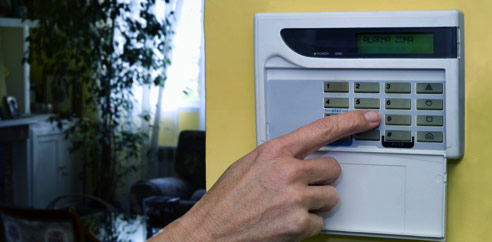What Is an Intrusion Alarm System?
 In today’s world, protecting your business is important, and a reliable intrusion alarm system is essential for doing so. These systems protect premises, assets, and employees from threats using components like video surveillance, access control, and burglar alarms.
In today’s world, protecting your business is important, and a reliable intrusion alarm system is essential for doing so. These systems protect premises, assets, and employees from threats using components like video surveillance, access control, and burglar alarms.
This article explains the various elements of intrusion alarm systems and their functionality, providing practical tips for managing them, such as handling after-hours access and false alarms. By understanding these systems, you can ensure comprehensive security for your business.
Components of an Intrusion Alarm System
An intrusion alarm system incorporates several components that work together to detect unauthorized entry and send alerts to the appropriate people.
Video Surveillance
Video surveillance offers constant monitoring and recording of activities within and around business premises. These systems incorporate IP cameras, which use the internet to send and receive data. This allows for remote access and advanced features like high-resolution imaging and motion detection. Video surveillance deters potential intruders, provides evidence in case of incidents, and enhances overall security through real-time monitoring and recording.
Access Control
Access control systems regulate who can enter or exit different areas within a business, ensuring only authorized personnel can access sensitive locations. Common examples of access control systems include key card systems and biometric scanners. Access control offers significant advantages: it restricts unauthorized access, logs entry and exit times in detail, and allows easy management and updates to accommodate changes in staff or access needs.
Burglar Alarm
A burglar alarm plays a fundamental role in an intrusion alarm system by detecting unauthorized entry and alerting the appropriate parties. These detection devices can either connect directly to the system control panel through wiring or operate wirelessly using batteries and radio signals for communication.
Burglar alarms can include motion sensors, door and window sensors, and audible sirens. These components deter intruders and notify occupants and security personnel. The benefits of burglar alarms are clear. They provide immediate alerts of potential break-ins and deter criminal activity. Plus, they can be integrated with other security measures for comprehensive protection.
How an Intrusion Alarm System Works
An intrusion alarm system uses a network of sensors and detectors to monitor entry points and sensitive areas within a business.
When a window sensor detects the opening of a window or a glass break detector picks up the sound of breaking glass, the system triggers an alarm.
Motion detectors use technologies like infrared or microwave to sense movement within protected areas and set off alarms if they detect unauthorized activity.
Each sensor communicates with a central control panel, which processes the signals and activates the alarm. The control panel can alert security personnel, trigger audible alarms to deter intruders, and notify business owners or security monitoring services of the breach.
This coordinated effort ensures that any unauthorized access is promptly identified and addressed, providing robust protection for the business.
Managing the System in Certain Scenarios
Managing an intrusion alarm system effectively involves setting clear protocols for various scenarios, such as employee access after hours and handling false alarms.
- Accessing the business outside of working hours. For after-hours access, ensure employees are well-informed about security procedures. They should know how to disarm the alarm system upon entry. They should also know how to reactivate it upon exit. Providing authorized personnel with unique access codes or key cards can streamline this process.
- False alarms. In the event of a false alarm, businesses should have a clear protocol in place to quickly address and resolve the issue. Employees should be trained to stay calm, verify the cause of the alarm, and immediately report the incident to the designated security contact or monitoring service.
Establishing these protocols helps maintain security and reduces the stress and potential disruptions caused by false alarms.
Response Protocols After an Alarm Sounds
When an alarm sounds, immediate and calm response protocols are essential to ensure safety and resolve the situation quickly.
The first step is to assess the situation to determine if there is an actual threat or a false alarm. If a threat is present, employees should follow evacuation or lockdown procedures and contact emergency services.
In the case of a false alarm, designated personnel should reset the system and inform the security provider or monitoring service about the incident.
Have a documented protocol outlining these steps and ensure all employees are trained to follow them. Clear communication and swift action can help minimize disruptions and maintain a secure business environment.
Intrusion alarm protocols are key to protecting your business
An intrusion alarm system is a vital component of any business’s security strategy. These alarm systems offer comprehensive protection through video surveillance, access control, and burglar alarms. Understanding how these systems work and managing them effectively in various scenarios ensures that your business is always secure.
Implementing clear protocols for after-hours access and false alarms is essential. Knowing how to respond appropriately when an alarm sounds is equally important. These measures help business owners maintain a safe and secure environment for their assets and employees.
NEXT STEPS:
- Contact us today to learn more about security and surveillance for your business.
- Learn more about what home or business security means to us.
- Subscribe to our blog to stay informed about the latest security news and insight.

















